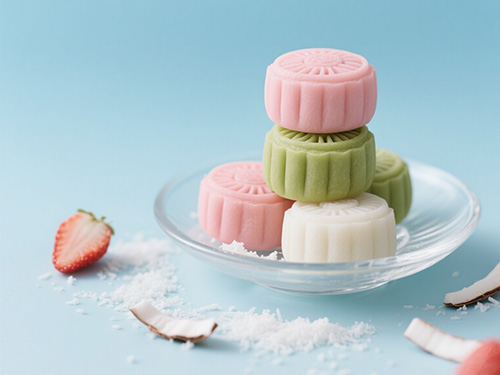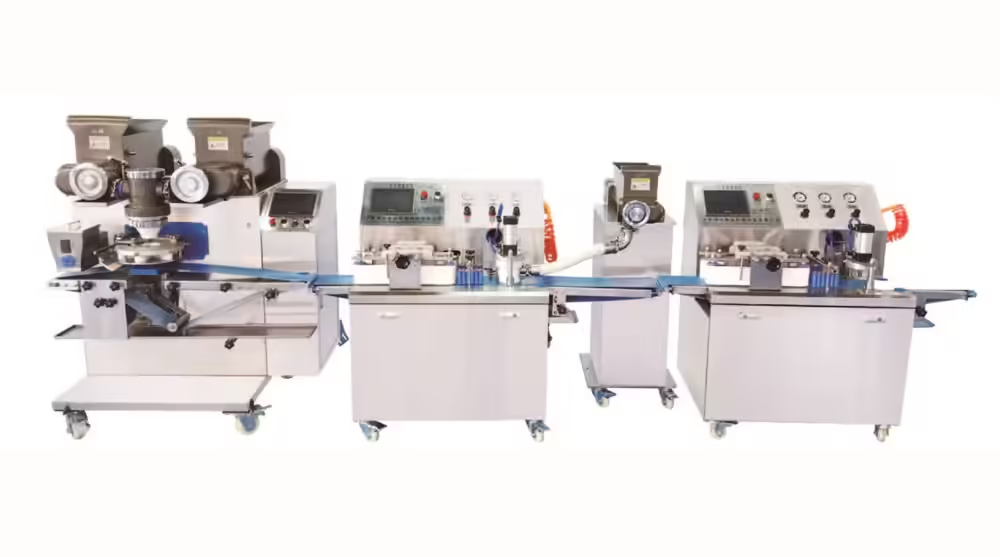


Explore how mooncake production has evolved from traditional methods to automation, preserving flavor while boosting efficiency and consistency.

Mooncakes, a beloved delicacy, have been the centerpiece of the Mid-Autumn Festival for centuries. Symbolizing unity, wholeness, and the changing seasons, they play a vital role in celebrating family and reunion. These exquisite pastries, with their golden crusts and rich fillings, hold deep ties to cultural traditions.
Yet while their cultural significance remains unchanged, the craft of making moon cakes has undergone a dramatic transformation over the years. The shift from entirely handmade production to modern automated methods has enabled moon cakes to meet the demands of global consumers, ensuring every bite delivers the same authentic flavor regardless of origin. This blog explores how mooncake-making has evolved from ancient techniques to contemporary practices.
Cantonese mooncakes are among the most recognized, with their thin golden crust and rich, sweet fillings. Traditionally filled with lotus seed paste and salted egg yolk, these moon cakes embody the essence of the Mid-Autumn Festival. The thin, crisp crust is one of the defining features that sets Cantonese-style moon cakes apart.
Originating from Suzhou, Su-style mooncakes are famous for their crispy, flaky texture and savory fillings. Unlike the sweet fillings of their Cantonese counterparts, Su-style moon cakes are often filled with salted meats, such as pork or duck, providing a more savory flavor profile. These moon cakes showcase the diversity of the craft.
Snow skin mooncakes have gained popularity in recent years, offering a soft, chewy texture that contrasts the traditional baked moon cake. Filled with everything from fruit pastes to chocolate and even ice cream, these modern moon cakes reflect current trends and cater to the evolving tastes of consumers.
The quality of the moon cake filling is just as important as the dough itself. Fillings must have a consistent viscosity to ensure they maintain their shape and texture during baking. With innovations in filling techniques, automated systems can guarantee that each filling is mixed and dispensed to perfection, preserving quality across large batches.
The traditional process of making moon cakes involves a series of delicate steps: preparing the dough, creating the filling, wrapping the dough around the filling, shaping the moon cake, and baking it. In ancient times, each step was done by hand, requiring great skill and attention to detail. The craftsperson would measure the dough, ensure the filling was evenly distributed, and carefully shape each mooncake.
Despite its artisanal roots, the handmade process faces challenges when it comes to scaling production. Handcrafting moon cakes in large quantities can result in inconsistencies in size, shape, and quality, and the reliance on skilled labor makes it difficult to meet the growing demand.
As demand for mooncakes continues to grow, the challenge for manufacturers is to maintain traditional quality while increasing production to meet global needs. Modern-day manufacturers face pressure to maintain consistent flavor, texture, and appearance across large volumes. Handcrafted methods, while offering uniqueness, struggle with scaling.
The question then arises: How can producers maintain traditional moon cake flavors and craftsmanship without sacrificing efficiency and consistency? The answer lies in technology and automation.
The shift to automated production lines has revolutionized mooncake manufacturing, enabling producers to retain the traditional flavor and craftsmanship while meeting the growing demand for consistency and efficiency.
The dough serves as the foundation of a good moon cake. Automated dough preparation systems ensure that each batch has the perfect consistency, with uniform hardness, elasticity, and moisture content. This precision, which would be difficult to achieve by hand, ensures the dough remains the same from batch to batch, maintaining the quality of the finished product.
Automated filling machines have made it easier than ever to fill moon cakes with precision. These machines ensure that the filling-to-dough ratio is exact, preventing issues like leakage or disproportionate filling. By controlling the filling viscosity, automated systems also ensure that the consistency and flavor are maintained throughout the production process.
The visual appeal of a mooncake is just as important as its taste. With automated molding and stamping machines, manufacturers can ensure that every moon cake is uniform in shape and design. These machines press delicate patterns into the surface, creating crisp, clear designs that are difficult to replicate by hand.
Once the mooncakes are shaped, they are transferred to automated ovens for baking. Advanced tunnel ovens ensure precise temperature control and consistent baking across all mooncakes. The cooling process is equally critical to maintain the moon cakes’ texture and prevent over-baking. Automated cooling lines quickly bring the moon cakes to the right temperature, ensuring they maintain their freshness and quality.
The art of mooncake making represents a perfect fusion of tradition and innovation. While the artisanal techniques passed down through generations remain highly cherished, the advent of pastry production lines has enabled large-scale manufacturing without compromising quality. Automated systems deliver the precision required to ensure product consistency, minimize errors, and uphold hygiene standards, all while preserving the traditional flavors cherished by people worldwide during the Mid-Autumn Festival.
As technology continues to advance, we anticipate further innovations in pastry production lines, ensuring that traditional delicacies like mooncakes continue to bring joy to families globally.
What are the main types of mooncake fillings?
Mooncakes traditionally come in lotus seed paste, red bean paste, salted egg yolks, and savory fillings. Modern variations include chocolate, fruit, and ice cream fillings.
Can I use automation for traditional moon cake recipes?
Yes, automation enhances traditional mooncake production by ensuring consistent quality while maintaining traditional recipes.
How does automated moon cake production affect the taste?
Automated production lines are designed to maintain the same high quality and traditional flavor as handmade moon cakes by controlling the key variables like dough consistency, filling proportions, and baking temperature.
Why is automation crucial for large-scale moon cake production?
Automation enables bakeries to meet high production demands while maintaining consistency, hygiene, and quality, which is difficult to achieve with manual methods.


